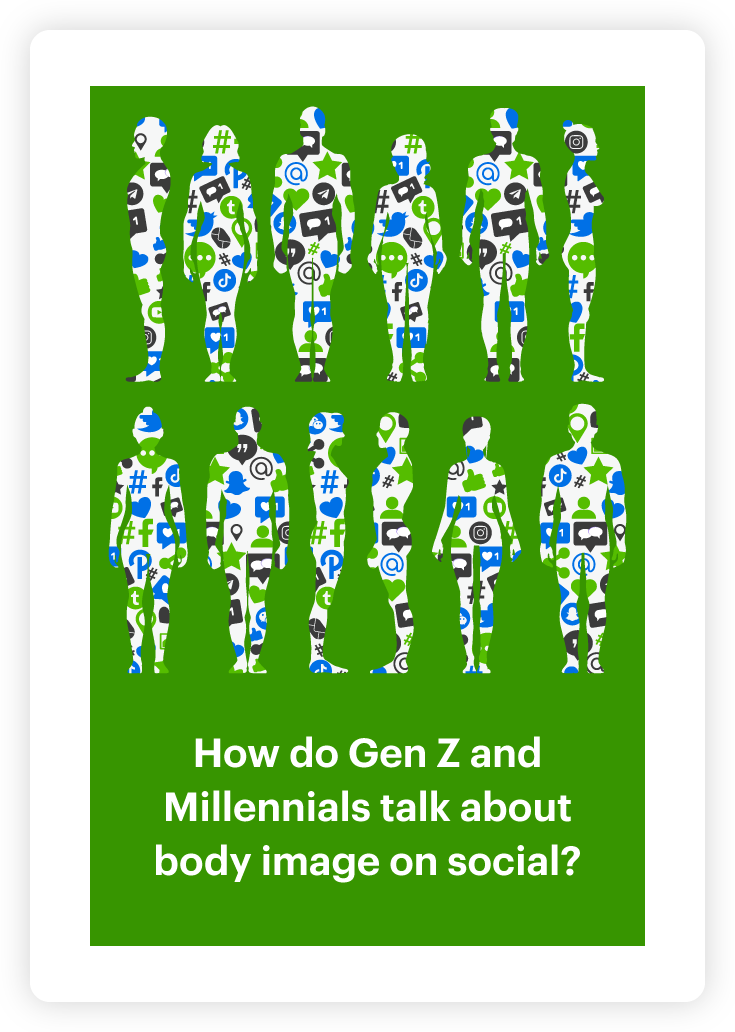Tracking Gen Z’s changing attitudes on fashion

The pandemic shifted our habits in a variety of ways, but none more so than the clothes we wore. With lockdowns in full swing, we swapped uncomfortable jeans for comfy joggers, and while pjyamas suddenly became workwear of choice, there was suddenly more pressure on fashion brands to undertake unplanned target market research to ensure their product lines didn’t become obsolete.
With lockdowns easing and people’s habits changing again, their fashion choices have shifted once more. But how are certain demographics talking about the clothes they wear – and how has this changed?
To find out, we decided to focus on perhaps the most fashion-conscious demographic: generation Z. We gathered gen Z fashion conversations on social media over the course of a year, from April 2021 to April 2022, and used text analysis and data visualization to understand the key areas of discussion and gen Z’s changing attitudes to fashion.
We began by uploading our social target market research data into Relative Insight Explore. Explore allows you compare multiple data sets and find key differences between them. When examining the data for gen Z fashion trends, we found five key areas for further analysis: preparation, discomfort, holiday outfits, concert outfits and feeling pleased. Having identified these discussion points using Explore, we created themes covering these conversations in Relative Insight Heartbeat to track how they changed over time.
By using Heartbeat to track conversations over time for your handpicked themes you can distinguish between short-term flashpoints and long-term trends. This analysis provides you with real-time business intelligence you can use to inform decision making across your organisation.
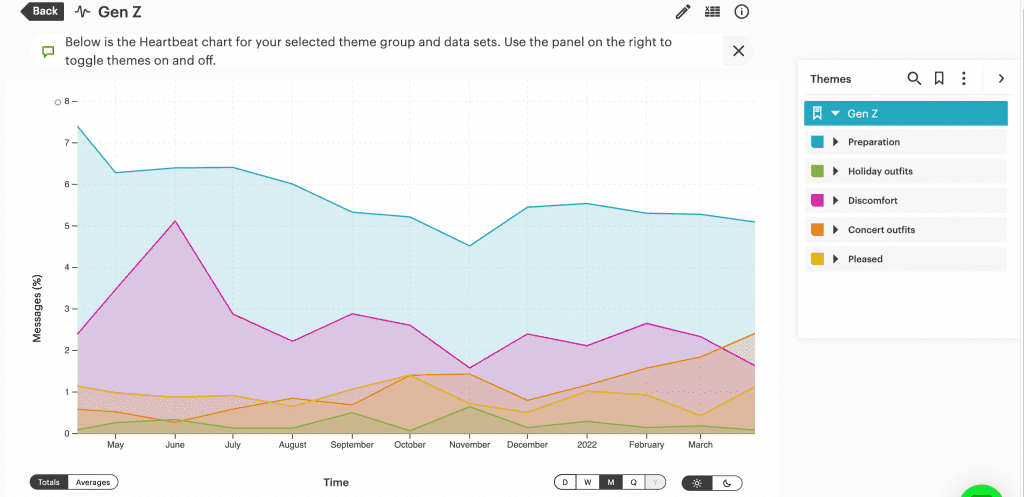

As you can see from the Heartbeat chart above, there was considerable variation in conversations around four of the themes we identified, while conversations around ‘feeling pleased’ remained broadly similar across the time period. We shall examine the fluctuations in gen Z’s changing attitudes to fashion for each of the other four themes in more detail.
Preparation key to gen Z fashion trends
One constant theme of generation Z’s fashion conversations was preparation. This theme incorporates phrases such as ‘hair’, ‘makeup’, ‘wash’, ‘shower’, ‘laundry’ and ‘clean’ alongside fashion. What the Heartbeat chart shows us is this theme was most prevalent in tweets at the beginning of our date range, in April 2021. With many countries only just beginning to ease lockdown restrictions, gen Z conversations revolved around the novelty of going out – and preparing for it. This included references to consumers wearing make-up, washing their hair or ensuring they were clean before heading outdoors.
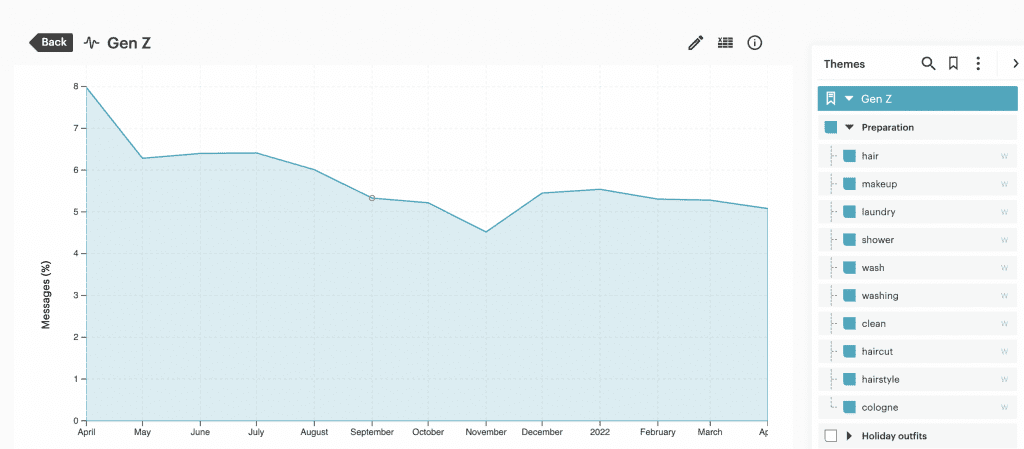

While this remained a fairly consistent topic of discussion over the 12 months, our audience research on gen Z’s changing attitudes to fashion shows that mentions fell as lockdown restrictions were lifted and going out became a more regular part of people’s lives. Mentions rose again between November and December, likely due to Christmas parties and other festive events, before leveling out for the rest of the period.
Gen Z style can be uncomfortable
Some clothes that look great can also be irritating to wear. This is a theme of this demographics conversation which peaked three months into our time comparison, before becoming less frequent.
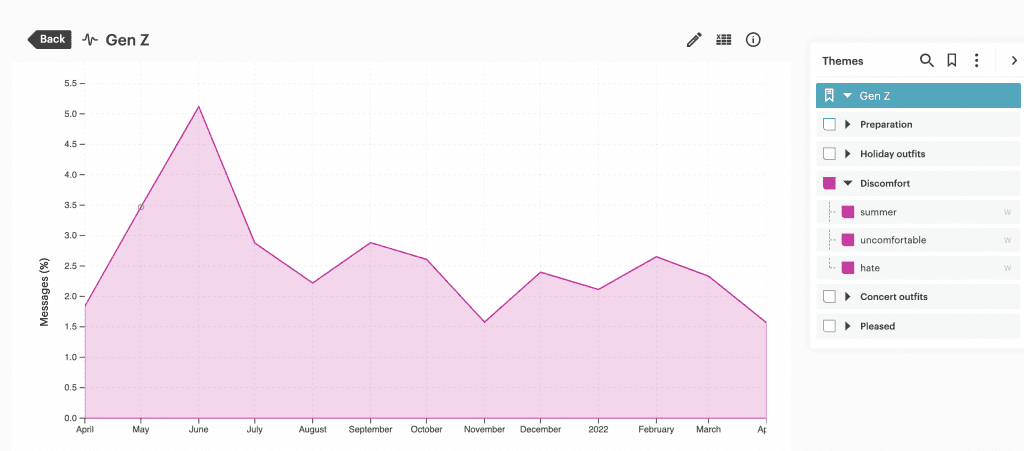

As Covid-19 restrictions were eased and summer approached, gen Z swapped joggers for warm weather outfits. The Heartbeat chart demonstrates that this change in clothing choice led to complaints, with our target audience research finding consumers increasingly using words like ‘uncomfortable’ and ‘hate’, as well as referencing the tightness of summer clothes.
Following the early summer spike, gen Z consumers adapted and therefore began to complain less about clothing fit. While there were small rises in discomfort discussion around September and December, likely due to summer and Christmas overconsumption, this theme becomes less pronounced heading into 2022.
Holiday outfits weren’t a big gen Z fashion trend
Holiday and summer clothes are typically a huge market for fashion retailers, however, it isn’t something gen Z have been discussing. Our target audience research on gen Z’s changing attitudes to fashion analyzed the use of words including ‘airport’ and ‘travel’. We can see that – despite spikes in September and November – conversations mentioning holiday-specific fashion are low, with a peak frequency of 0.65% of all gen Z fashion tweets highlighting holiday outfits.
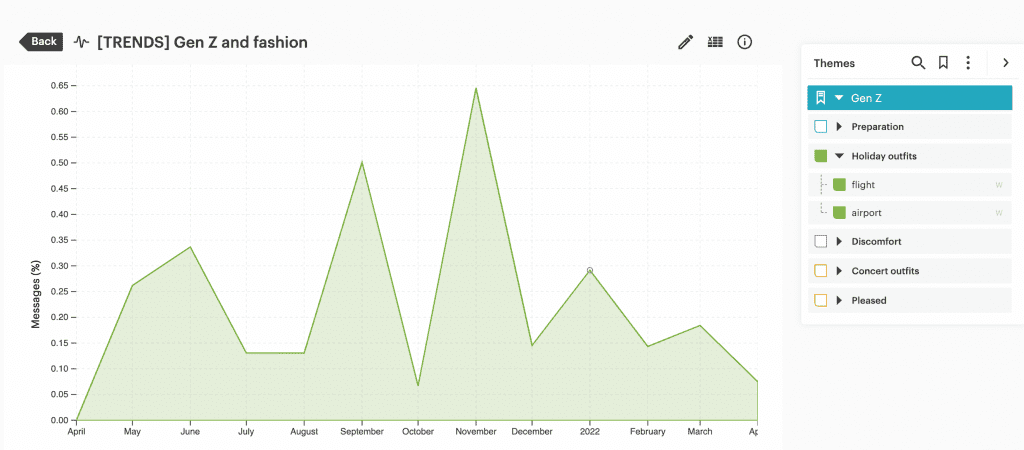

This may be due to travel restrictions remaining in place for the majority of the time period we tracked – meaning fewer people were going on holiday and therefore not discussing holiday outfits. It may also be that conversations around uncomfortable clothes not only related to summer outfits, but included holiday clothes too without mentioning the word specifically. Or, quite simply, gen Z style discussions aren’t geared around holidays.
Conversation around concert fashion is key target market research finding
The biggest actionable insight we derived from our audience research on gen Z’s changing attitudes to fashion was that gen Z style conversations increasingly focus on festivals and concerts, rather than holidays. Conversations are increasingly featuring words like ‘concert’, ‘music’ and ‘Coachella’, as well as the 🎵 emoji.
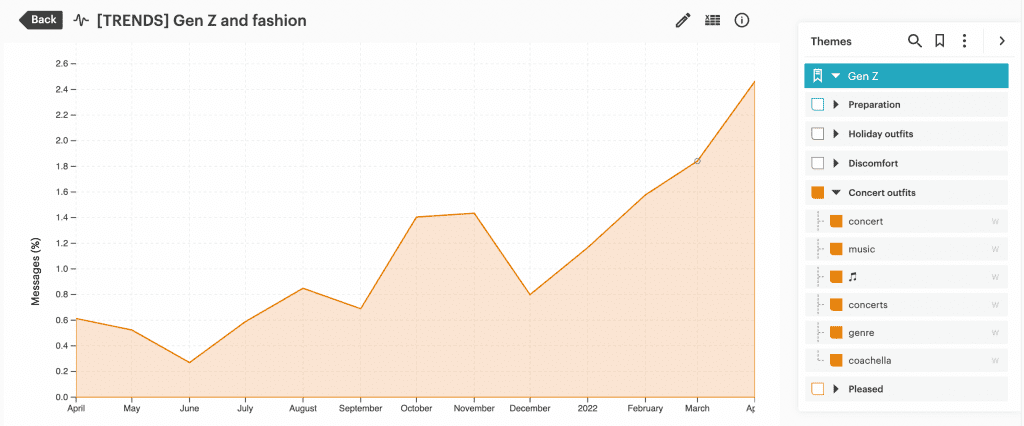

Discussion around concert and gig fashion entirely mirrors Covid-19 restrictions around these events. With some restrictions still in place for spring and summer 2021 and continuing uncertainty around whether concerts would go ahead, there was minimal discussion about what to wear for these events. Greater certainty around gigs from September onwards meant that gen Z had confidence they would be attending these events, allowing conversation to turn to what they were going to wear.
With the emergence of the Omicron variant and the reintroduction of coronavirus restrictions, conversations about concert clothes plateaued and then fell as Christmas approached. Once this new Covid wave was safely navigated and restrictions were relaxed for good from early 2022, discussion around concert outfits by gen Z has surged – undoubtedly supported by the prominence of discussion surrounding Coachella in April.
How fashion brands should respond to this gen Z audience research
Analyzing gen Z’s changing attitudes to fashion through Relative Insight Explore and tracking changes in discussion around handpicked themes through Relative Insight Heartbeat allows fashion brands to spot a clear opportunity when targeting gen Z consumers.
It is clear that discussion surrounding clothes for concerts, festivals and gigs has greatly increased since the beginning of 2022. Brands who are agile enough to pivot their gen Z messaging to account for this conversation, and away from more conventional seasonal fashion messaging, will gain an edge.
Understanding the context around shifting online conversations in fast-moving, trend-led sectors like fashion is key to brands maximising their value. Relative Insight Heartbeat allows you to visualize vast quantities of text data, enabling you to easily identify the difference between a flashpoint, such as spikes in discussions about holiday outfits, and long-term trends to which brands need to adapt – like conversations around concert outfits.
Track social conversations
Relative Insight ran a global survey seeking to discover millennial insights and gen Z insights. We asked hundreds of respondents a whole host of open-ended questions about sustainability, ethics, what and how they buy, what they would never buy on principle, personal brand identity and even emojis, and the results are in
